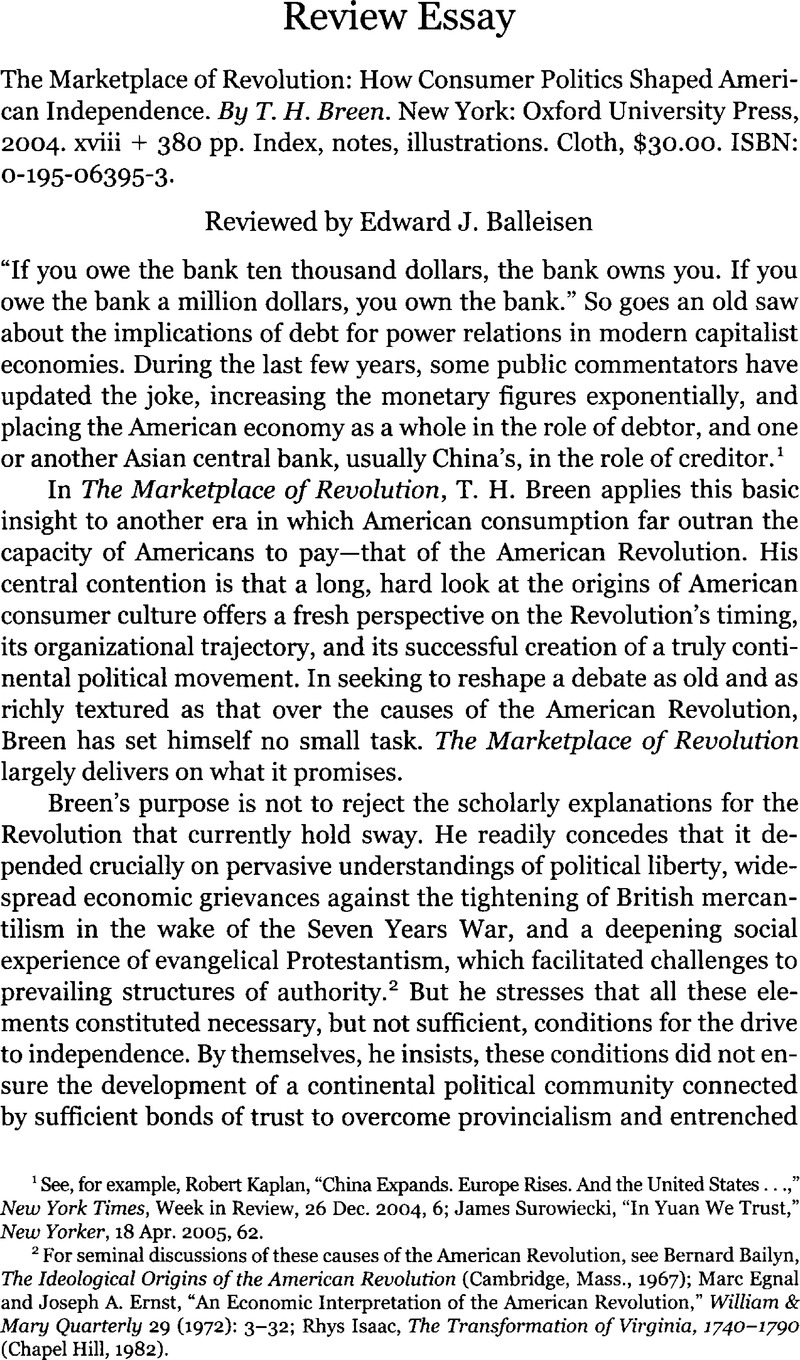No CrossRef data available.
Published online by Cambridge University Press: 13 December 2011

1 See, for example, Robert Kaplan, “China Expands. Europe Rises. And the United States…,” New York Times, Week in Review, 26 Dec. 2004, 6; James Surowiecki, “In Yuan We Trust,” New Yorker, 18 Apr. 2005, 62.
2 For seminal discussions of these causes of the American Revolution, see Bailyn, Bernard, The Ideological Origins of the American Revolution (Cambridge, Mass., 1967)Google Scholar; Egnal, Marc and Ernst, Joseph A., “An Economic Interpretation of the American Revolution,” William & Mary Quarterly 29 (1972): 3–32CrossRefGoogle Scholar; Isaac, Rhys, The Transformation of Virginia, 1740-1790 (Chapel Hill, 1982).Google Scholar
3 Breen's method shares a great deal with the approach adopted by practitioners of the “Political Development” school of political science, who are especially interested in explaining the timing and form of pivotal political events. For an introduction to the relevant literature, see Pierson, Paul, “Increasing Returns, Path Dependence, and the Study of Politics,” American Political Science Review 94 (June 2000): 251–67CrossRefGoogle Scholar, and the scholarship cited therein.
4 Breen's previous scholarship exploring these themes includes: Tobacco Culture: The Mentality of the Great Tidewater Planters on the Eve of Revolution (Princeton, 1985)Google Scholar; “An Empire of Goods: The Anglicization of Colonial America, 1690-1776,” Journal of British Studies 25 (1986): 467–99CrossRefGoogle Scholar; “‘Baubles of Britain’: The American Consumer Revolutions of the Eighteenth Century,” Past and Present 119 (1988): 73–104CrossRefGoogle Scholar; “Narrative of Commercial Life: Consumption, Ideology, and Community on the Eve of the American Revolution,” William & Mary Quarterly 50 (1993): 471–501CrossRefGoogle Scholar. For leading statements of the view that this era was profoundly characterized by a communitarian, precapitalist economic culture, see: Merrill, Michael, “Cash is Good to Eat: Self-Sufficiency and Exchange in the Rural Economy of the United States,” Radical History Review 17 (1977): 42–71Google Scholar; Henretta, James, “Families and Farms: Mentalite in Pre-Industrial America,” William & Mary Quarterly 35 (1978): 3–32CrossRefGoogle Scholar. For pivotal scholarship that emphasizes the extent of capitalist social relations and cultural norms in early America, apart from Breen's work, see: Shammas, Carole, The Preindustrial Consumer in England and America (Oxford, 1990)Google Scholar; Rothenberg, Winifred, From Marketplaces to a Market Economy: The Transformation of Rural Massachusetts, 1750-1850 (Chicago, 1992)Google Scholar; and Bushman, Richard, “Markets and Composite Farms in Early America,” William & Mary Quarterly 55 (1998): 351–74.CrossRefGoogle Scholar
5 For scholarship that raises these kind of queries, see: Young, Alfred, ed., The American Revolution: Explorations in the History of American Radicalism (Dekalb, III., 1976)Google Scholar; Nash, Gary, The Urban Crucible: Social Change, Political Consciousness, and the Origins of the American Revolution (Cambridge, Mass., 1979)CrossRefGoogle Scholar; Holton, Woody, Forced Founders: Indians, Debtors, Slaves, & the Making of the American Revolution (Chapel Hill, 1999)Google Scholar.